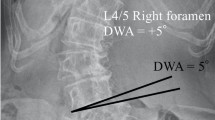Abstract
Purpose
To compare measurements of lumbar neuroforaminal dimensions (NFD) derived from plain film radiography (PFR) and computed tomography (CT) of young patients without spinal pathology.
Methods
We analyzed 213 patients between 18 and 35 years of age without spinal pathology who received PFR and CT within one year of each other. NFD were defined as foraminal height, sagittal anterior-to-posterior width, and area. Statistical analyses assessed correlations and differences between PFR- and CT-derived NFD measurements.
Results
111 subjects were female and 102 were male. Significant differences between PFR- and CT-derived NFD measurements were observed for all levels L1-S1, with those for foraminal height listed as follows: 4.10 mm at L1-L2, 1.58 mm at L2-L3, 3.23 mm at L3-L4, 4.27 mm at L4-L5, and 1.75 mm at L5-S1. Regarding foraminal area, these differences were 72.20, 73.45, 61.80, 35.38, and 16.18 mm2, respectively. PFR-derived measurements of NFD were larger compared to those derived from CT across all levels (p < .001). Only weak (0 ≤ r ≤ .4) or moderate (.4 ≤ r ≤ .7) correlations were observed between PFR- and CT-derived NFD measurements for all levels from L1-S1.
Conclusion
This study describes 9585 measurements from L1-S1 of neuroforaminal measurements derived from CT and plain film radiography from a sample of young patients without spinal pathology. Among these patients, plain film measurements of the neuroforamina are larger compared to those derived from CT for all levels from L1-S1. There is poor correlation and reliability between plain film and CT measurements of neuroforaminal dimensions.


Similar content being viewed by others
Data availability
The datasets generated and analyzed during the current study are available from the corresponding author on reasonable request.
References
Steurer J, Roner S, Gnannt R, Hodler J (2011) Quantitative radiologic criteria for the diagnosis of lumbar spinal stenosis: a systematic literature review. BMC Musculoskelet Disord 12:175. https://doi.org/10.1186/1471-2474-12-175. (LumbSten Research Collaboration)
Jenis LG, An HS (2000) Spine update. Lumbar foraminal stenosis Spine 25(3):389–394. https://doi.org/10.1097/00007632-200002010-00022
Choi YK (2019) Lumbar foraminal neuropathy: an update on non-surgical management. Korean J Pain 32(3):147–159. https://doi.org/10.3344/kjp.2019.32.3.147
Kalichman L, Cole R, Kim DH et al (2009) Spinal stenosis prevalence and association with symptoms: the Framingham study. Spine J Off J North Am Spine Soc 9(7):545–550. https://doi.org/10.1016/j.spinee.2009.03.005
Lee S, Lee JW, Yeom JS et al (2010) A practical MRI grading system for lumbar foraminal stenosis. AJR Am J Roentgenol 194(4):1095–1098. https://doi.org/10.2214/AJR.09.2772
Anonymous et al. *Details omitted for double-blind review*
Karaikovic EE, Daubs MD, Madsen RW, Gaines RWJ (1997) Morphologic characteristics of human cervical pedicles. Spine 22(5):493
Singh K, Samartzis D, Vaccaro AR et al (2005) Congenital lumbar spinal stenosis: a prospective, control-matched, cohort radiographic analysis. Spine J 5(6):615–622. https://doi.org/10.1016/j.spinee.2005.05.385
Hazra A, Gogtay N (2016) Biostatistics series module 3: comparing groups: numerical variables. Indian J Dermatol 61(3):251–260. https://doi.org/10.4103/0019-5154.182416
Akoglu H (2018) User’s guide to correlation coefficients. Turk J Emerg Med 18(3):91–93. https://doi.org/10.1016/j.tjem.2018.08.001
Schober P, Boer C, Schwarte LA (2018) Correlation coefficients: appropriate use and interpretation. Anesth Analg 126(5):1763–1768. https://doi.org/10.1213/ANE.0000000000002864
Razzouk J, Ramos O, Ouro-Rodrigues E et al (2022) Comparison of cervical, thoracic, and lumbar vertebral bone quality scores for increased utility of bone mineral density screening. Eur Spine J. https://doi.org/10.1007/s00586-022-07484-5
Lee CM, Liu RW (2022) Comparison of pelvic incidence measurement using lateral x-ray, standard ct versus ct with 3d reconstruction. Eur Spine J 31(2):241–247. https://doi.org/10.1007/s00586-021-07024-7
Bono CM, Vaccaro AR, Fehlings M et al (2007) Measurement techniques for upper cervical spine injuries: consensus statement of the spine trauma study group. Spine 32(5):593. https://doi.org/10.1097/01.brs.0000257345.21075.a7
Sieradzki JP, Karaikovic EE, Lautenschlager EP, Lazarus ML (2008) Preoperative imaging of cervical pedicles: comparison of accuracy of oblique radiographs versus axial CT scans. Eur Spine J 17(9):1230–1236. https://doi.org/10.1007/s00586-008-0725-7
Lee SE, Lee WK, Kim DS et al (2010) Comparison of radiographic and pathologic sizes of renal tumors. World J Urol 28(3):263–267. https://doi.org/10.1007/s00345-010-0511-0
Choi SM, Choi DK, Kim TH et al (2015) A comparison of radiologic tumor volume and pathologic tumor volume in renal cell carcinoma (RCC). PLoS ONE 10(3):e0122019. https://doi.org/10.1371/journal.pone.0122019
Chen W, Wang L, Yang Q, Liu B, Sun Y (2013) Comparison of radiographic and pathologic sizes of renal tumors. Int Braz J 39(2):189–194. https://doi.org/10.1590/S1677-5538.IBJU.2013.02.06
Marchant MH, Willimon SC, Vinson E, Pietrobon R, Garrett WE, Higgins LD (2010) Comparison of plain radiography, computed tomography, and magnetic resonance imaging in the evaluation of bone tunnel widening after anterior cruciate ligament reconstruction. Knee Surg Sports Traumatol Arthrosc 18(8):1059–1064. https://doi.org/10.1007/s00167-009-0952-4
Ito MM, Tanaka S (2006) Evaluation of tibial bone-tunnel changes with X-ray and computed tomography after ACL reconstruction using a bone-patella tendon-bone autograft. Int Orthop 30(2):99–103. https://doi.org/10.1007/s00264-006-0078-y
Hoser C, Tecklenburg K, Kuenzel KH, Fink C (2005) Postoperative evaluation of femoral tunnel position in ACL reconstruction: plain radiography versus computed tomography. Knee Surg Sports Traumatol Arthrosc Off J ESSKA 13(4):256–262. https://doi.org/10.1007/s00167-004-0548-y
Wang HJ, YFAo, LXChen et al (2013) Measurement of bone tunnel width with computed tomography versus plain radiography after anterior cruciate ligament single-bundle reconstruction. Zhonghua Yi Xue Za Zhi 93(41):3288–3290
Senol U, Cubuk M, Sindel M et al (2001) Anteroposterior diameter of the vertebral canal in cervical region: comparison of anatomical, computed tomographic, and plain film measurements. Clin Anat 14(1):15–18. https://doi.org/10.1002/1098-2353(200101)14:1%3c15::AID-CA1002%3e3.0.CO;2-X
Author information
Authors and Affiliations
Corresponding author
Ethics declarations
Conflict of interest
All authors certify that they have no affiliations with or involvement in any organization or entity with any financial interest or non-financial interest in the subject matter or materials discussed in this manuscript.
Additional information
Publisher's Note
Springer Nature remains neutral with regard to jurisdictional claims in published maps and institutional affiliations.
Rights and permissions
Springer Nature or its licensor (e.g. a society or other partner) holds exclusive rights to this article under a publishing agreement with the author(s) or other rightsholder(s); author self-archiving of the accepted manuscript version of this article is solely governed by the terms of such publishing agreement and applicable law.
About this article
Cite this article
Razzouk, J., Carter, D., Carter, M. et al. Comparison of L1-S1 neuroforaminal dimensions derived from plain film radiography versus computed tomography. Eur Spine J 33, 93–102 (2024). https://doi.org/10.1007/s00586-023-08005-8
Received:
Revised:
Accepted:
Published:
Issue Date:
DOI: https://doi.org/10.1007/s00586-023-08005-8




